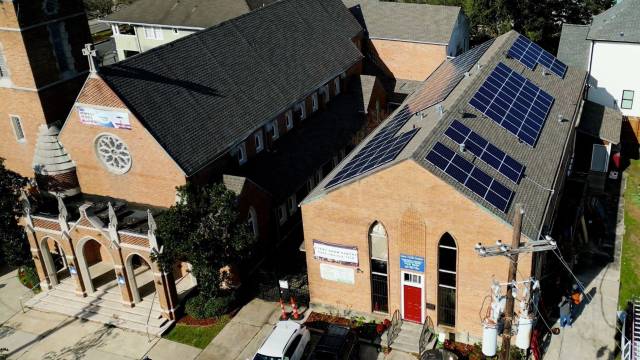You are here
Community Lighthouses Guide the Way
When Hurricane Ida hit Louisiana in 2021, over a million residents lost power—a familiar and dangerous problem in the region. “The number one killer in the Gulf South, related to a disaster, is power outages,” said Nathanael Wills, an organizer with Together Louisiana, a nonprofit coalition of more than 250 religious congregations and civic organizations.
Prolonged blackouts can interfere with safe food storage and medical equipment, increase the risk of heat-related illnesses and deaths and leave vulnerable populations, like the elderly, with no means of contacting emergency medical support. After Ida, power outages lasted for three weeks and were linked to nearly a dozen deaths. Local civic leaders and pastors in New Orleans decided to take matters into their own hands and began devising a new community-driven strategy to give residents safe, reliable places to get the care and resources they need in a disaster.
“We've got to make sure there's a place in every neighborhood that already has a plan and the infrastructure so that we can take care of each other,” Wills said. “And you really can't do it without power.”
In 2022, Together Louisiana launched their Community Lighthouse project, an ongoing initiative to create a statewide network of solar-powered disaster response hubs, known as community lighthouses. Located in churches, nonprofits and other familiar, trusted sites, the lighthouses are designed to provide refuge and electricity for residents during weather-related blackouts.
Each lighthouse building is equipped with a micro-electrical grid comprised of rooftop solar panels that generate electricity that is then stored in back-up batteries. The lighthouse locations can use the solar energy to supplement their day-to-day needs, while also storing ample power that can be easily accessed during emergencies, even when the local electrical system goes down.
In September 2024, the lighthouses were put to the test when Hurricane Francine knocked out power to over 400,000 people. Residents were able to quickly make full use of the facilities. “We had nine lighthouses open within 10 to 12 hours of the storm hitting,” Wills said. “We served 2,300 people, distributed 1,800 meals and a lot of water.”
The lighthouses also have portable batteries, approximately the size of a rolling suitcase, that are easily transported to individuals in need and safer to use than a gas-powered generator. These were especially useful during Francine when volunteers discovered a nearby senior center without power. “We sent a team over there, they started going door to door and found people sitting in the dark, in the hot, people that couldn’t move,” Wills said. “And so, we started taking batteries to them.”
The lighthouse technology is impressive, but Wills is quick to point out that the success of the initiative really relies on the volunteers behind each location. “We are building teams of what we call ‘lighthouse keepers’ who are intentionally doing outreach to the neighborhoods, learning how we'll operate the lighthouses when the time comes,” Wills said.
With support from the Gulf Research Program at the National Academy of Science, Engineering and Medicine and the CDC Foundation, Together Louisiana is training their lighthouse keepers on effective disaster preparedness and response. The teams survey residents, asking about their experiences in prior storms, identifying people who rely on electricity for their medical needs and creating a 24-hour call list of those who will need a check-in during an emergency.
“We're trying to build that social infrastructure,” said Madison Poche, executive director at the Highland Center—a nonprofit community center that recently became the second community lighthouse in Shreveport, Louisiana. “Talking with neighbors and saying, ‘We have these resources available in an emergency. What do you need? And what do you have?’”
There are currently 19 lighthouses in operation, with three more under construction, and Together Louisiana plans to build as many as 500 across the state. The coalition hopes this growing network of safe havens will strengthen communities and ensure they stay connected to food, water, electricity and each other, through any disaster.
“The building of the lighthouses is exciting, but what it unlocks is people’s ability to have compassion and initiative to do what they know how to do—take care of each other,” Wills said. “That’s kind of the beauty of it.”


